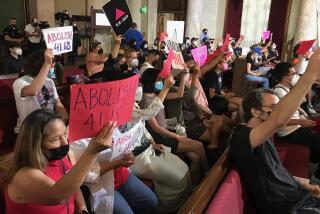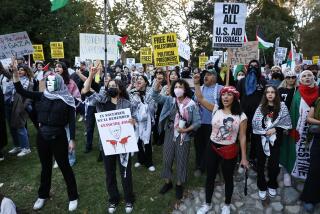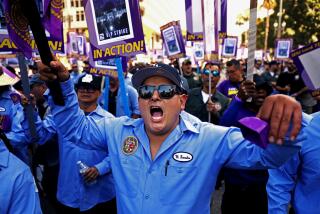Tensions grow at Occupy L.A. as deadline nears
Activists and L.A. officials faced difficult choices over the next phase of the Occupy L.A. movement as a 12:01 Monday deadline approached for the departure of nearly 700 protesters from an encampment on City Hall grounds.
On Sunday evening, Mayor Antonio Villaraigosa reiterated an ultimatum that the city’s tolerance of the eight-week occupation would end at midnight.
“While Occupy L.A. has brought needed attention to the economic disparities in our country, an encampment on City Hall grounds is simply not sustainable indefinitely,” he said in a statement.
The mayor also sought to allay concerns over a confrontational midnight sweep. Police would “allow campers ample time to remove their belongings peacefully and without disruption,” he said.
Some protesters had already begun to tear down their tents Sunday afternoon. But many more announced their intention to stay put, and supporters arrived throughout the afternoon and evening, swelling the camp’s ranks.
Protesters were planning to rally at 11 p.m. and remain throughout the night.
As of Sunday, Occupy L.A. had become the nation’s largest remaining around-the-clock outpost for a nationwide movement that arose when the loose-knit group Occupy Wall Street moved into a park in the financial district of New York City. Police there swept in Nov. 15 and roughly removed demonstrators who refused to disperse after nearly two months.
Police also have been accused of heavy-handed tactics in dislodging occupiers in Oakland and at UC Davis and UC Berkeley, among other places. In Los Angeles, authorities were at pains to stay on good terms with demonstrators over the eight weeks. But authorities weren’t prepared to let the encampment go on indefinitely.
“I am proud of the fact that this has been a peaceful, nonviolent protest,” Villaraigosa said. “It has been peaceful because we have done things differently in Los Angeles.”
The political stakes are high for Villaraigosa, who could suffer fallout if anything went wrong — such as being too soft or too harsh on protesters.
The movement itself can and must persist locally and nationally, said Maria Elena Durazo, head of the L.A. County Federation of Labor.
“While the tents may come down, the actions against Wall Street and the banks will rise,” Durazo said.
Some participants in Occupy L.A. said that forcible removal would not prevent them from trying to reclaim their ground.
“We will remain occupiers,” said Julie Levine, who served as one of several Occupy spokespeople on Sunday. “It’s a symbol of the discontent in the nation and the world.”
Others said that if removed from City Hall, the encampment would spread to multiple sites.
L.A. officials have offered daily gathering space, until 10:30 p.m., on the west steps of City Hall. And on Sunday, City Councilman Bill Rosendahl pledged that a committee would attempt to pursue the movement’s goals within city government. That agenda includes divesting from major banks that have played a role in the nation’s foreclosure crisis.
“We want a peaceful transition from this land to action,” Rosendahl said.
His midday Sunday pitch to take the movement indoors — and into established politics drew a sometimes combative reception.
“We need a public space where we can do this 24/7, not on a permitted basis a few hours of the day,” said activist Summer Reese.
Some organizers talked of seeking a court injunction to halt eviction, or of going to court after the fact to reinstate their hold on the green space.
The movement has resisted selecting formal leadership. Instead, it’s tried to develop consensus at evening general assemblies. That structure has made tactical and policy decisions painstaking and difficult, although acutely democratic.
A landscaper who identified himself as Mike B. used his truck Sunday to transport valuable equipment to a secure location, preserving the infrastructure of Occupy L.A.’s welcome tent, medical tent, food tent and media tent. The city has promised to make parking available nearby to help people move belongings.
Participants also were trying to sort out aid for homeless and mentally ill campers who congregated in large numbers on the north side of City Hall.
Workers from the L.A. Homeless Services Authority will be available Monday with information about health services. And the city has arranged for 50 shelter beds to serve homeless campers. Additional winter shelters will open Thursday.
Uncertainty over the future added to a strangely festive atmosphere, which included a concert featuring the punk band NOFX and hundreds of visitors to a makeshift mini-city that included 543 tents and about 600 to 700 residents.
Rick Mendoza, 35, a nurse from Riverside, brought two young children and a niece to witness history. But they didn’t stay long. His family was bothered by the omnipresent haze from burning sage — an attempt by some to purify the space.
Near sunset, labor and clergy leaders called for nonviolence on both sides. And some indicated they might take part in peaceful resistance.
“I believe the genius of the Occupy movement is exactly their grounding in nonviolent civil disobedience,” said Jim Conn, director of new ministries at United Methodist Church in L.A.
On Friday, 171 faith leaders sent Villaraigosa a letter urging him to continue negotiations with Occupy L.A. Several were scheduled to meet with the mayor Monday.
Protesters from out of town added to potential complications. Some even flew in from out of state for the occasion.
A contingent from Occupy Irvine included Shay Peterson, 50, dressed in a blue gown and chains, holding a torch and wearing a crown: Lady Liberty in bondage.
“I thought this was appropriate because freedom of speech is being put down at midnight today,” she said.
A camper who identified himself as John Barrymore Jr., an acting teacher and voice-over actor, planned to stay only until authorities arrived.
But he wasn’t ready to give up on the occupation and expects the movement to find another public or high-profile space if City Hall remains off limits.
“It’s crucial to continue having a physical presence like a Hooverville,” he said, referring to the Depression-era camps named for President Hoover. “A tent city needs to be kept in America’s face.”
FULL COVERAGE: Occupy protests around the nation
More to Read
Start your day right
Sign up for Essential California for news, features and recommendations from the L.A. Times and beyond in your inbox six days a week.
You may occasionally receive promotional content from the Los Angeles Times.









